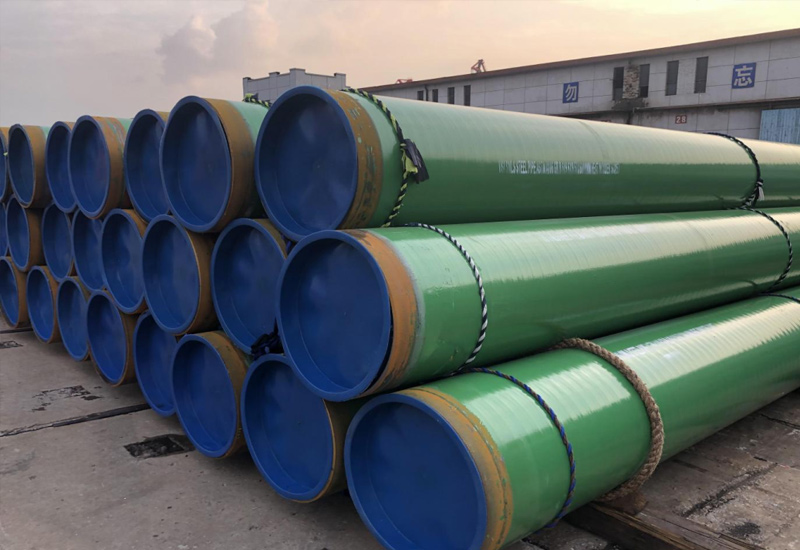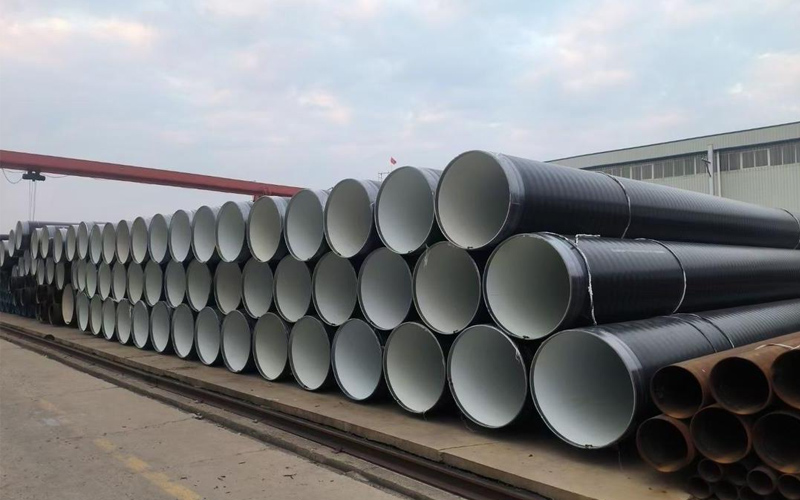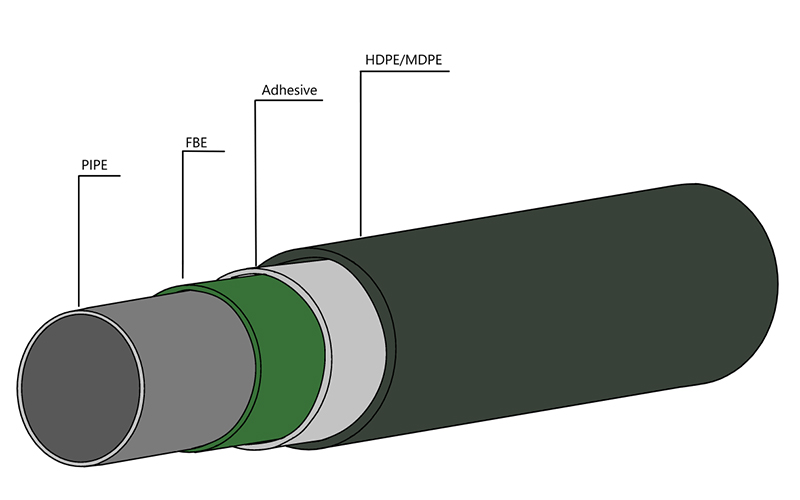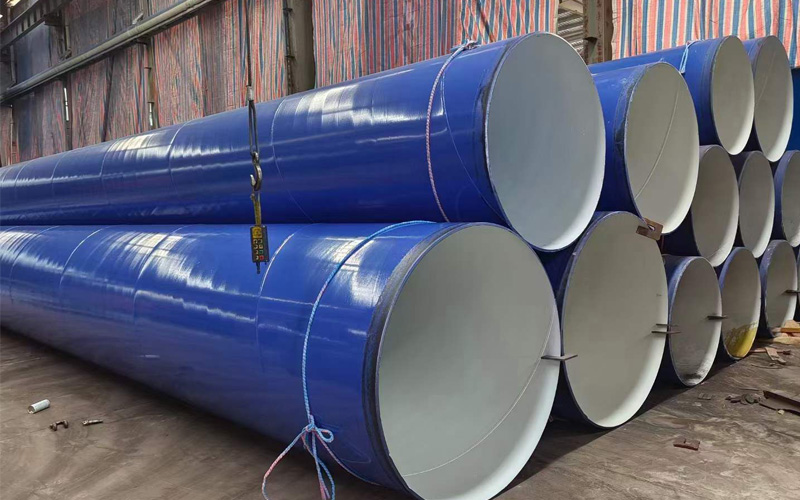3LPP coated pipe: anti-corrosion guard in high temperature and high pressure environment
In some challenging special environments such as deep-sea oil and gas exploration and high-temperature crude oil transportation, traditional anti-corrosion coatings face significant challenges, and their anti-corrosion performance is not strong enough. The high temperature resistance and corrosion resistance brought by the unique three-layer structure of 3LPP coated pipe are becoming a key technology to solve the problems of these industries. This innovative anti-corrosion system combines the adhesive properties of FBE and with the mechanical strength of PP to provide a reliable solution for modern energy facilities.
1. Coating material and precision production: triple protection in high temperature environment
The 3LPP (three-layer polypropylene anti-corrosive layer) structure is composed of three key materials to form a synergistic defense system:

Laminated epoxy powder base (FBE): Directly coated on the surface of sandblasted steel pipe to provide cathodic stripping protection and basic adhesion. This layer, about 100-250 microns thick, forms a strong chemical bond with the steel surface.
Intermediate layer of copolymer adhesive (PPA): modified polypropylene copolymer is used to melt and combine with the bottom layer FBE and the surface layer polypropylene at high temperature to form a strong bonding bridge. This layer solves the problem of interfacial compatibility between polypropylene and epoxy resin.
Polypropylene (PP) surface layer: Serving as the outermost protective layer, the PP layer offers several key advantages: —— Long-term temperature resistance up to 110°C (significantly higher than the 70°C limit of 3LPE), lower water absorption rate (only 0.01% after 24 hours), and superior wear resistance. The 3LPP coating thickness typically are 1.8-4.0mm, and for special applications like submarine pipelines, it can be increased to 8.5mm to enhance mechanical damage resistance.
The production process of 3LPP pipe coating needs to be completed in a professional 3LPP pipe plant,
The main steps include:
The steel pipe is sandblasted to Sa 2.5 cleanliness and the specified anchor depth
Electrostatically spray FBE powder and cure
The PPA adhesive is extruded and wound when the FBE is gelatinized
The surface layer of molten polypropylene is synchronously coated
Water cooling molding and quality inspection (sparking leak detection, thickness measurement)
The process must meet stringent standards, such as ISO 21809-2 3LPP and DIN 30678. Leading domestic companies, including Baoji Petroleum Steel Pipe Co., Ltd., have achieved independent production of 3LPP coated pipes. Their X70 grade, 711mm diameter pipes feature an external anti-corrosion layer thickness of 8.5mm, with peel strength and other performance indicators reaching international standards.
2. Performance comparison: the comprehensive comparison between 3LPP and un-coated, FBE and 3LPE steel pipes
When selecting pipeline anti-corrosion solutions, the performance of the coating under different working conditions should be comprehensively evaluated:
| Performance index | Un-coated steel pipe | FBE coated steel pipe | 3LPE coated steel pipe | 3LPP coated steel pipe |
| Maximum operation temperature | Unrestricted | ≤ 115°C (long term) | ≤70°C (long term) | ≤ 110°C (long term) |
| Mechanical resistance | Lowest | Low (highly brittle) | High | Very high (PP hardness> PE) |
| Cathode stripping resistance | Rely on cathodic protection | Outstanding | Outstanding | Excellent (FBE underlying guarantee) |
| Abrasion performance | Lowest | Secondary | Outstanding | Outstanding |
| Resistance to chemical attack | No | good | good | Excellent (PP is more acid and alkali resistant) |
| Total life cycle cost | High (requires ongoing maintenance) | Secondary | Medium to low | Low (maintenance free life> 50 years) |
The core advantages of 3LPP steel pipeline are particularly prominent in high temperature and mechanical harsh scenarios:
Temperature resistance breakthrough: the temperature of crude oil in the submarine pipeline of Wenchang Oilfield reaches 92°C, which cannot be handled by the traditional 3LPE pipe coating, while the 3LPP coating runs stably
Impact resistance: The elastic modulus of polypropylene is higher than that of polyethylene, so it is less likely to be damaged under the impact of rock backfill area or seabed gravel
Life cycle economy: Although the initial cost is higher than 3LPE, the 50-year maintenance-free design significantly reduces the operation and maintenance expenditure
Key differences
1. Material and structural differences
3LPE:
FBE bottom layer + adhesive + polyethylene (PE) surface layer
Advantages: Good flexibility, low cost
3LPP:
FBE bottom layer + adhesive + polypropylene (PP) surface layer
Advantages: PP has more rigid molecular chain, higher heat resistance and mechanical strength
2. Temperature adaptability
3LPE:
PE will soften above 70°C (e.g., surface pipelines in the Middle East desert are prone to deformation)
3LPP:
The PP can withstand a temperature of 110°C (suitable for the Wenchang oil field crude oil of 92°C and refinery pyrolysis pipeline)
3. Mechanical and environmental performance
| Function | 3LPE | 3LPP |
| Shock strength | 20 kJ/m²(-20°C) | 45 kJ/m² (-20°C, deep-sea gravel impact) |
| Abrasion performance | 100 mg (1kg / 1000 rpm) | 60 mg (same conditions, pulp pipeline life increased by 30%) |
| Cathodic disbonding | ≤8mm(48h/65°C) | ≤6mm (extreme standard ISO 21809-2) |
3. Special application scenarios: overcoming the extreme environment of energy transmission
3LPP coated steel pipe is irreplaceable in many key fields due to its high temperature resistance and deep water pressure resistance:
High temperature oil and gas pipeline
When transporting heavy oil or deep well crude oil, the medium temperature often exceeds 80°C. For example, the pipeline oil temperature in Wenchang Oilfield of CNOOC is 92°C, and 3LPP coated pipe is successfully used to solve the problem of corrosion failure. Deepwater projects in Gulf of Mexico and North Sea oil fields also widely use such pipelines.
Deep sea oil and gas development
The deep-sea high-pressure environment requires the coating to be both pressure-resistant and resistant to low temperature brittleness. The modified 3LPP coating can be used in water below-30°C by optimizing the PP formulation (such as blending elastomers). Its density is lower than polyethylene, which is more conducive to buoyancy control of submarine pipelines.
Chemical high temperature medium pipeline
In a refinery or chemical plant, the pipeline conveying pyrolysis products needs to withstand temperatures above 110°C. 3LPP steel pipeline replaces the traditional FBE single layer coating in such scenarios to avoid the risk of leakage due to FBE cracking.
Geothermal and steam delivery system
Geothermal wellhead pipeline or district heating network needs to be in contact with high temperature hot water/steam for a long time. The hydrolysis resistance of polypropylene surface layer is significantly better than that of polyethylene, which makes it the preferred solution for such projects.
In these projects, 3LPP pipe specifications are usually required to meet ISO 21809 or DNVGL-RP-F102 standards. Global well-known 3LPP pipe suppliers such as Baoji Petroleum Steel Pipe in Baoji and EUROPIPE in Europe all have full process certification qualifications.
At the same time, 3LPP pipe welding procedure needs to pay special attention to joint compatibility.
Before girth welding, the end coating is peeled off and the 30° bevel is machined
It is recommended to use TIG welding + hot wire process to control the oxidation of the weld of bimetallic composite pipe.
After welding, a three-layer polypropylene heat shrinkable tape or irradiated cross-linked polyethylene tape is used to ensure that the lap area is sealed.
4. Conclusion
The 3LPP coated steel pipe, through the innovative use of a polypropylene surface layer, has surpassed the traditional anti-corrosion coating’s temperature limit of 70°C. It demonstrates outstanding protective performance in harsh environments such as high temperatures of 110°C and deep-sea pressures. Its three-layer composite structure (FBE-PPA-PP) ensures chemical corrosion resistance, mechanical strength, and long-term thermal stability, making it the preferred solution for high-temperature oil and gas transportation, deep-sea development, and chemical pipeline networks.
As energy development advances into high-temperature and high-pressure environments, the demand for 3LPP-coated pipes that meet international standards such as ISO 21809-2 3LPP will continue to grow. Leading 3LPP pipe suppliers are enhancing coating performance by optimizing material formulations (such as copolymer-modified PP) and automating the coating process. In the future, 3LPP steel pipelines are expected to not only solidify their position in the subsea pipeline market but also expand into new energy sectors, including hydrogen transportation and geothermal development.
From materials science to engineering practice, 3LPP coating technology is redefining the boundaries of high temperature corrosion protection and laying the foundation for the safe operation of global energy infrastructure.
Get Your Custom Steel Pipe Quote Today!
Provide us with your project details (like application, specifications, quantity). Our experienced team will respond with a tailored solution and competitive quote within 24 business hours.
Related Articles
ASTM A53 vs. API 5L: A Guide to Selection and Application
Introduction:Technology differences determine success or failure, and selection needs to be “precise”
Steel Density Analysis: Core Differences between Mild and Medium Carbon Steels and Industrial Applications
3LPE coated steel pipe: a solid barrier in the field of industrial corrosion protection
FBE steel pipe: the technological armor of the steel defense line
How LSAW/SSAW Steel Pipes Ensure Safe & Durable Drinking Water Pipelines
HOT TAGS
latest posts
- How LSAW/SSAW Steel Pipes Ensure Safe & Durable Drinking Water Pipelines
- LSAW steel pipe vs ERW steel pipe: Unveiling Core Process Differences in Steel Pipe Welding from Arc to Current
- The Essential Guide to High Pressure Pipe Applications
- API 5L Grades Explained: X52, X65 & X70 Meaning?
- A Guide to Offshore Steel Pipe & Tubes for Subsea Projects














